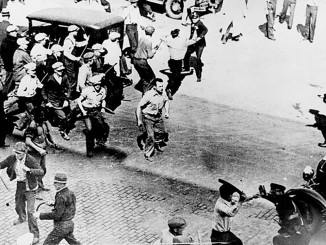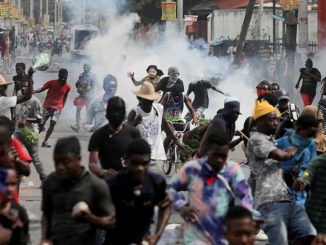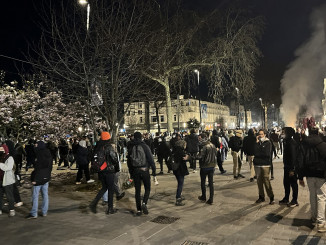Looking back on 2013, we see a volatile world, a world of increasing misery but also explosive anger. Cynicism and despair can erupt into anger and resistance at any moment. In this period nothing is predictable and anything is possible.
The Robbery of the Working Class
The capitalist class has enriched itself in record amounts by robbing the working class. Companies are making more money than at any time since 1947. Bank profits broke the records for the last three years, making about 175 billion dollars last year. In the U.S. the wealth gap is larger than at any time in history. The richest one percent own 42 percent of all the wealth, and the richest ten percent owns 85 percent. CEOs earn 380 times the average worker – it takes a worker two months to earn what a CEO makes in an hour.
The rich have gotten richer only because workers have gotten poorer. Companies have fired workers, cut our overall pay or benefits, and pushed more work onto fewer of us. Today fewer Americans are working than at any time in the last forty years. Meanwhile in 2012, for the first time ever, global corporations invested more in foreign markets than in the U.S. And even more in 2013. The consequences for much of this investment has been intensified misery for the international working class, and a decrease in wages and living standards for everyone.
Ravaging the Planet
Global energy production has continued to increase in every major category – oil, coal, and natural gas, dumping more carbon into the atmosphere and accelerating the warming of the planet. Like the U.S., world energy companies have resorted to the most destructive methods available in their race for the dwindling reserves of energy – including blowing up mountaintops, more dangerous deep water drilling, going after reserves in the newly melted arctic, and poisoning water supplies through the polluting gas-extraction process known as fracking.
Profits Before People
The policies of the capitalist class and their political servants aim at one goal – profit. This is true even when they promise to solve real problems. For example, under the Affordable Care Act, what was promoted as affordable health insurance has only become a way to force people to pay for very expensive insurance and medical care. The profits of the health care industry are expected to more than double in the next two years. Health care costs have increased by over 27 percent in the last two years. This law may have provided some small benefit to working people, but it has been a gold mine for the health care industry.
Last year we saw the true priorities of the politicians. The Democrat and Republican parties could not agree upon how large to make the cuts to social services. Last March, $85 billion was cut from programs funding education and other social services, forcing hundreds of thousands of government workers to take unpaid furloughs. Over 600,000 children from poor families were cut from food assistance, and about 125,000 families were cut from federal housing assistance. And when politicians couldn’t agree upon another round of deep cuts, they instead provoked the temporary so-called government shutdown, disrupting the lives of millions of poor and working class families by canceling funding, laying off workers, and closing down programs. The priorities of the government couldn’t be any clearer – they put the profits of the corporations first.
The consequence of all of this is our lives are even more difficult, especially for the poorest sections of society. According to the Sf Chronicle, over the past ten years, the number of black men killed on the streets of Oakland was almost equal to the number who graduated from Oakland high schools ready to attend a state university. Oakland has nearly twelve robberies per day, has the highest crime rate in California, and leads the country in the number of robberies per 100,000 people. And Oakland is in no way unique. In 2012, there were 131 homicides in Oakland, 513 in Chicago, 500 in Los Angeles, 414 in New York, 410 in Detroit, 324 in Philadelphia and 200 in Baltimore, totaling 2492 deaths in these cities alone. Without hope and the chance to live a decent life, the level of violence will not go away. In this climate, would anyone be surprised if there were explosions of anger coming from any of these cities?
The Resilience of the Working Class
Despite all of the attacks, there is still resistance in the working class not just around the world but in this country too. In every major country from South Africa, to Egypt, Brazil, Indonesia, China, India, and South Korea, workers have been waging struggles to resist exploitation.
And in the U.S., coal mining towns have seen dozens of actions blocking the destructive practice of mountain top removal. Native American organizations along with other activists in different states have worked together to block further oil extraction on ancient lands and in wildlife areas, protesting the proposed Keystone pipeline. Citizens in dozens of cities across the country have blocked energy companies from carrying out fracking, polluting the air and making their water supply toxic.
Last year we also saw increased determination by hundreds of undocumented immigrant youth. Young people who have grown up in this country undocumented have begun to openly demand full citizenship rights, defying deportation, protesting in front of immigration buildings.
In workplaces we have seen small signs of resistance. This year, some of the lowest paid workers in the fast food and service industry began organizing to increase the minimum wage and win the right to have a union. In the Bay Area, workers at BART and AC Transit refused to just go along with the attacks of management. At AC transit, workers voted against a concessionary contract twice. And BART workers engaged in two limited strikes against the arrogance of BART management, showing the Bay Area the potential power of transit workers on strike. These struggles hinted at the potential that could be unleashed if workers are able to organize their forces together.
While these struggles have been very small and have not led to any major victories, they show that despite the difficult times we are living in, that not all workers are passive in the face of these attacks.
We can’t expect the assault by the ruling class around the world to let up. They are confident they can take more from us, amassing even more wealth. But at the same time, we can be sure that the potential for workers to stand up and fight together is also within reach. 2014 and the coming years will be the time for workers to begin to come together, joining our struggles, standing up to these attacks, and fight for a world that is run for our interests, the needs of the vast majority of the people, not the interests and wealth of a narrow few.




